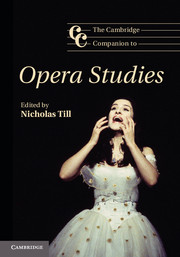Book contents
- Frontmatter
- Contents
- Contributors
- Acknowledgements
- Introduction: opera studies today
- Part One Institutions
- Part Two Constituents
- 4 ‘Too much music’: the media of opera
- 5 Voices and singers
- 6 Opera and modes of theatrical production
- 7 Opera and the technologies of theatrical production
- Part Three Forms
- Part Four Issues
- Further reading
- Index
- References
4 - ‘Too much music’: the media of opera
from Part Two - Constituents
Published online by Cambridge University Press: 05 December 2012
- Frontmatter
- Contents
- Contributors
- Acknowledgements
- Introduction: opera studies today
- Part One Institutions
- Part Two Constituents
- 4 ‘Too much music’: the media of opera
- 5 Voices and singers
- 6 Opera and modes of theatrical production
- 7 Opera and the technologies of theatrical production
- Part Three Forms
- Part Four Issues
- Further reading
- Index
- References
Summary
Richard Strauss’s last opera, Capriccio (1942), reflects on an issue that has preoccupied opera since its birth in the Italian courts of the late Renaissance. Which is more important, it asks, the words or the music? Is it ‘prima la musica, dopo le parole’ (first the music, then the words) or ‘prima le parole, dopo la musica’ (first the words, then the music)? Capriccio suggests that the answer lies in a genuine symbiosis that privileges neither, implying, with a wink, that the opera itself is a demonstration of that symbiosis. Things haven’t always been so harmonious. To its critics opera always seemed to lack the economy of means so treasured, at various historical moments, in verbal, musical and theatrical arts, while its apparently haphazard and bloated combinations suggested a forced marriage. Opera hasn’t even fared well in relation to other suspect hybrids like theatre. The term ‘theatrical’ has often encompassed negative associations with falsehood, superficiality and emotive excess, not least for the modernists, who, as Martin Puchner has shown, derided theatricality as a trope for everything that modern art disavows. Yet the victimized finds its own victim: in many theatrical circles musical forms of theatre, including opera, stand for something debased in relation to what is still referred to as ‘legitimate theatre’. Is it that too much is given away to music? Does music need to be kept in check to avoid swamping theatre’s heterogeneous mix of literary, gestural and visual components in a flood of homogenizing sound? Isn’t the opera house really a concert hall with scenery?
This is certainly one strand of the historical critique of opera, which is saturated with arguments for the reform of operatic practice in the name of drama and poetry, as though curbing the genre’s instinctive tendency to indulge music. Measured against the possibility of rediscovering a lost unity between poetry and music in Hellenic theatre – a conviction shared by so many of the theorists and practitioners of opera, from the Florentine Camerata through the eighteenth-century philosophers to Wagner – opera was always haunted by an ancient ghost and found wanting by comparison.
- Type
- Chapter
- Information
- The Cambridge Companion to Opera Studies , pp. 95 - 116Publisher: Cambridge University PressPrint publication year: 2012
References
- 4
- Cited by

